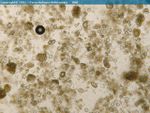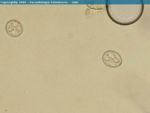Difference between revisions of "Coccidiosis - Cattle"
(Created page with 'thumb|right|150px|''Eimeria'' sp. of ruminants - Joaquim Castellà Veterinary Parasitology Universitat Autònoma de Barcelona [[Image:Coccidia ooc…') |
|||
| (16 intermediate revisions by 4 users not shown) | |||
| Line 1: | Line 1: | ||
| − | [[Image:Coccidia ruminant.jpg|thumb|right|150px| | + | {{OpenPagesTop}} |
| − | [[Image:Coccidia oocyst ruminant.jpg|thumb|right|150px|Coccidia oocyst from ruminant faeces - Joaquim Castellà Veterinary Parasitology Universitat Autònoma de Barcelona]] | + | == Introduction == |
| − | + | [[Image:Coccidia ruminant.jpg|thumb|right|150px|<i>Eimeria</i> sp. of ruminants - Joaquim Castellà Veterinary Parasitology Universitat Autònoma de Barcelona]] [[Image:Coccidia oocyst ruminant.jpg|thumb|right|150px|Coccidia oocyst from ruminant faeces - Joaquim Castellà Veterinary Parasitology Universitat Autònoma de Barcelona]] | |
| + | Coccidiosis is primarily a disease of groups of cattle less than one year old. It often occurs if these groups are housed or kept in unhygienic conditions, as like coccidiosis in other species, coccidiosis in cattle is a disease of over-crowding and poor hygiene. Calves with concurrent infections or ones with poor body condition are also susceptible. Bought-in calves that are then mixed with current stock is one of the primary causes of the disease and clinical signs are usually apparent around a month after this event has occurred. | ||
| − | + | Infection is usually sporadic, but once immunity has developed it is likely not to recur. During the neonatal period, passive immunity is sufficient, only after this wanes are clinical signs of the disease apparent. | |
| − | + | There are many species of [[:Category:Coccidia|coccidia]] that affect cattle, but ''[[Eimeria spp.|Eimeria]] zuernii, E. bovis'' and ''E. alabamensis'' are by far the most common. ''E. zuernii'' is the most pathogenic of these species. | |
| − | + | == Clinical Signs == | |
| − | |||
| − | |||
| − | |||
| − | |||
| − | + | All species of coccidia produce diarrhoea or dysentry with notable tenesmus. | |
| − | |||
| − | |||
| − | |||
| − | |||
| − | + | == Diagnosis == | |
| − | |||
| − | + | History and clinical signs plus husbandry and signalment of animals is indicative of the disease. | |
| − | + | Faecal samples should be taken for faecal floatation and microscopic examination for oocysts. High numbers of oocysts are indicative of clinical disease as small numbers of oocysts are present in all cattle. If the faecal sample is taken after the main oocyst production phase has passed then number will be low even in severely affected animals. | |
| − | + | Post mortem examination will reveal diffuse inflammation and thickening of caecal mucosa (and sometimes ileal and colonic mucosa). Scrapings of the mucosa should be taken and viewed microscopically. In an infected animal, masses of gamonts and oocysts will be present in these scrapings. | |
| − | + | == Treatment and Control == | |
| − | |||
| − | + | As with all causes of diarrhoea, supportive therapy such as rehydration and electrolyte solutions are necessary. | |
| − | |||
| − | |||
| − | + | Anti-coccidial drugs such as diclazuril or sulphonamides should be started once the diagnosis is confirmed and the affected animals should be moved to a clean environment. All in contact cattle should be treated with the same drug, should costs allow. | |
| − | |||
| − | |||
| − | + | Control measures focus on improving husbandry to decrease over-crowding, improve hygiene conditions and prevent mixing of newly purchased stock. | |
| − | |||
| − | |||
| − | |||
| − | |||
| − | + | Preventative in-feed medication can be supplied such as decoquinate. | |
| − | |||
| − | + | {{Learning | |
| − | + | |flashcards = [[Coccidia Flashcards|Coccidia Flashcards]] | |
| + | |||
| + | [[Cattle Medicine Q&A 04]] | ||
| + | }} | ||
| + | |||
| + | == References == | ||
| + | |||
| + | Andrews, A.H, Blowey, R.W, Boyd, H and Eddy, R.G. (2004) '''Bovine Medicine''' (Second edition), ''Blackwell Publishing'' | ||
| + | |||
| + | Fox, M and Jacobs, D. (2007) '''Parasitology Study Guide Part 1: Ectoparasites''''' Royal Veterinary College'' | ||
| + | |||
| + | Radostits, O.M, Arundel, J.H, and Gay, C.C. (2000) '''Veterinary Medicine: a textbook of the diseases of cattle, sheep, pigs, goats and horses''''' Elsevier Health Sciences'' | ||
| + | |||
| + | |||
| + | {{review}} | ||
| + | |||
| + | {{OpenPages}} | ||
| + | |||
| + | [[Category:Intestinal_Diseases_-_Cattle]] [[Category:Expert_Review - Farm Animal]] | ||
Latest revision as of 16:09, 30 July 2012
Introduction
Coccidiosis is primarily a disease of groups of cattle less than one year old. It often occurs if these groups are housed or kept in unhygienic conditions, as like coccidiosis in other species, coccidiosis in cattle is a disease of over-crowding and poor hygiene. Calves with concurrent infections or ones with poor body condition are also susceptible. Bought-in calves that are then mixed with current stock is one of the primary causes of the disease and clinical signs are usually apparent around a month after this event has occurred.
Infection is usually sporadic, but once immunity has developed it is likely not to recur. During the neonatal period, passive immunity is sufficient, only after this wanes are clinical signs of the disease apparent.
There are many species of coccidia that affect cattle, but Eimeria zuernii, E. bovis and E. alabamensis are by far the most common. E. zuernii is the most pathogenic of these species.
Clinical Signs
All species of coccidia produce diarrhoea or dysentry with notable tenesmus.
Diagnosis
History and clinical signs plus husbandry and signalment of animals is indicative of the disease.
Faecal samples should be taken for faecal floatation and microscopic examination for oocysts. High numbers of oocysts are indicative of clinical disease as small numbers of oocysts are present in all cattle. If the faecal sample is taken after the main oocyst production phase has passed then number will be low even in severely affected animals.
Post mortem examination will reveal diffuse inflammation and thickening of caecal mucosa (and sometimes ileal and colonic mucosa). Scrapings of the mucosa should be taken and viewed microscopically. In an infected animal, masses of gamonts and oocysts will be present in these scrapings.
Treatment and Control
As with all causes of diarrhoea, supportive therapy such as rehydration and electrolyte solutions are necessary.
Anti-coccidial drugs such as diclazuril or sulphonamides should be started once the diagnosis is confirmed and the affected animals should be moved to a clean environment. All in contact cattle should be treated with the same drug, should costs allow.
Control measures focus on improving husbandry to decrease over-crowding, improve hygiene conditions and prevent mixing of newly purchased stock.
Preventative in-feed medication can be supplied such as decoquinate.
| Coccidiosis - Cattle Learning Resources | |
|---|---|
 Test your knowledge using flashcard type questions |
Coccidia Flashcards |
References
Andrews, A.H, Blowey, R.W, Boyd, H and Eddy, R.G. (2004) Bovine Medicine (Second edition), Blackwell Publishing
Fox, M and Jacobs, D. (2007) Parasitology Study Guide Part 1: Ectoparasites Royal Veterinary College
Radostits, O.M, Arundel, J.H, and Gay, C.C. (2000) Veterinary Medicine: a textbook of the diseases of cattle, sheep, pigs, goats and horses Elsevier Health Sciences
| This article has been peer reviewed but is awaiting expert review. If you would like to help with this, please see more information about expert reviewing. |
Error in widget FBRecommend: unable to write file /var/www/wikivet.net/extensions/Widgets/compiled_templates/wrt6939fc284884e6_13170182 Error in widget google+: unable to write file /var/www/wikivet.net/extensions/Widgets/compiled_templates/wrt6939fc286456d7_13007989 Error in widget TwitterTweet: unable to write file /var/www/wikivet.net/extensions/Widgets/compiled_templates/wrt6939fc287cf6f5_78498591
|
| WikiVet® Introduction - Help WikiVet - Report a Problem |

